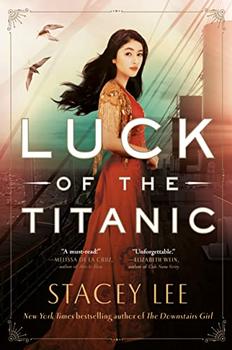Summary | Excerpt | Reviews | Beyond the Book | Read-Alikes | Genres & Themes | Author Bio

This article relates to Luck of the Titanic
 In Luck of the Titanic, we get a glimpse into the lives of Chinese passengers and workers aboard the famous "unsinkable" ship, including the xenophobia, racism and classism they face. At the beginning of the novel, author Stacey Lee explains that there were eight real-life Chinese passengers on the Titanic, of whom six survived. While their experience was different from that of the British Chinese characters Lee invented, they served as inspiration for her book. However, relatively little is known about them, as their stories have to an extent been filtered out of history.
In Luck of the Titanic, we get a glimpse into the lives of Chinese passengers and workers aboard the famous "unsinkable" ship, including the xenophobia, racism and classism they face. At the beginning of the novel, author Stacey Lee explains that there were eight real-life Chinese passengers on the Titanic, of whom six survived. While their experience was different from that of the British Chinese characters Lee invented, they served as inspiration for her book. However, relatively little is known about them, as their stories have to an extent been filtered out of history.
We do know that they were all male sailors who, prior to their 1912 voyage on the ship, had been out of work due to the coal strikes occurring in Britain at the time. They were traveling to New York to join a freighter bound for Cuba. Some of their names appeared differently across three separate documents — the United States immigration record, the outward passenger list for the Titanic and the New York Times survivor list — but they have been generally identified as Lee Bing, Fang Lang, Chang Chip, Ah Lam, Cheong Foo, Ling Hee, Lee Ling and Len Lam.
Six of the men survived, but all eight of them escaped the sinking Titanic. This may have been due to their experience as sailors and their knowledge of ships, which could have helped them find their way out of the lower decks of the third-class section of the boat. There have been conflicting reports regarding the two men who died, Lee Ling and Len Lam — one newspaper suggested that they hid themselves under the slats in a lifeboat and were crushed to death, but this claim was found to be false and it is probable they died from hypothermia like many of the other passengers.
The Chinese men who did live were not afforded the same treatment as the other survivors of the Titanic, who were welcomed into the US and immediately given aid and medical relief. Due to the Chinese Exclusion Act, which allowed only 105 Chinese immigrants into the US per year, they were detained and taken directly to their freighter. Chang Chip passed away from pneumonia not long after the sinking of the Titanic, in 1914, and was buried in an unmarked grave in London.
In addition to being turned away from the US, these men were vilified in newspapers throughout the West. Many claimed that they were stowaways, though they were fare-paying travelers. Regarding their survival, there was even more vitriol launched against them. Some publications stated that the men dressed as women to take priority over other male passengers when boarding the lifeboats. According to historian Tim Maltin, there is no proof of this allegation either, and the Chinese passengers actually attempted to help others survive. Sadly, it is thought that at least some of the men hid the story of the voyage even from their own families, possibly due to both the trauma and the stigma they faced. What is known of their experience is explored in the documentary The Six, from director Arthur Jones and producer Luo Tong.
The RMS Titanic departing Southampton on April 10, 1912. Photo by F.G.O. Stuart
Filed under People, Eras & Events
![]() This "beyond the book article" relates to Luck of the Titanic. It originally ran in June 2021 and has been updated for the
September 2022 paperback edition.
Go to magazine.
This "beyond the book article" relates to Luck of the Titanic. It originally ran in June 2021 and has been updated for the
September 2022 paperback edition.
Go to magazine.
Your guide toexceptional books
BookBrowse seeks out and recommends the best in contemporary fiction and nonfiction—books that not only engage and entertain but also deepen our understanding of ourselves and the world around us.